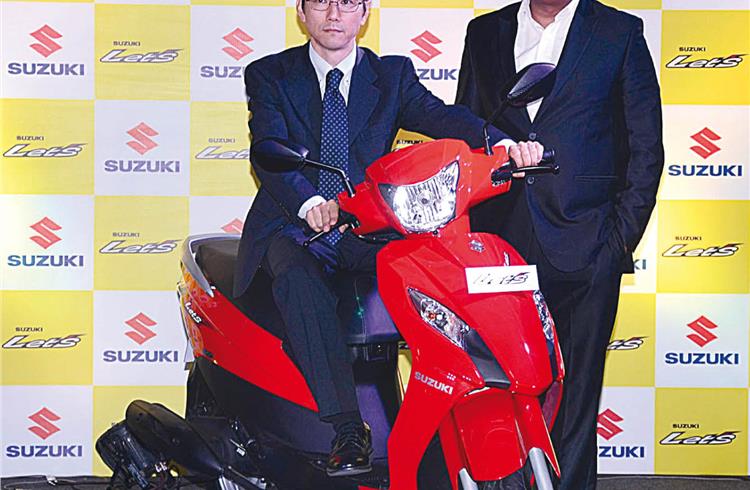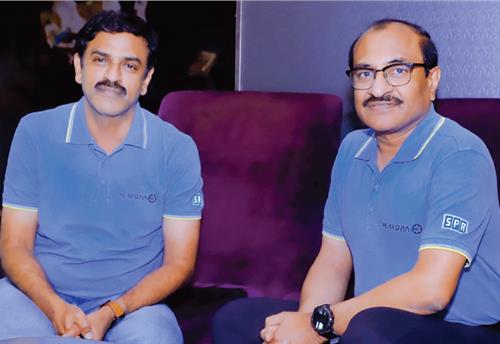Suzuki Motorcycle India gets into power mode
Suzuki’s two-wheeler arm in India plans to double exports, add 400 new dealers to its domestic network, and targets a five percent market share by the end of this fiscal, says Amit Panday.
Suzuki’s two-wheeler arm in India plans to double exports, add 400 new dealers to its domestic network, and targets a five percent market share by the end of this fiscal, says Amit Panday.
Suzuki Motorcycle India (SMIL), one of the top four scooter manufacturing OEMs in the domestic market, plans to double its exports in 2014-15. The company, which began actively focusing on exports last year, recorded cumulative shipments of 10,032 units in 2013-14. Now in a bid to step up its scale, SMIL plans to export 20,000 units to its existing export markets in 2014-15.
Speaking to Autocar Professional on the sidelines of the regional launch of its all-new 110cc Let’s automatic scooter in Pune on June 3, Atul Gupta, executive vice-president, SMIL, said: “This financial year, we will double our exports to neighbouring countries and some Latin American markets including Columbia and Ecuador. Our focus is on addressing the demand which already exists in these markets.”
Currently, the company’s export portfolio from India includes all the products manufactured at its Gurgaon plant. This will now expand to the Let’s scooter and possibly the new products slated for commercial launch later this year – the 150cc Gixxer motorcycle (rollout planned for August 2014) and an updated variant of the Hayate commuter motorcycle, which is expected to roll out
around the festival season later this year.
The Indian subsidiary of the Japanese two-wheeler giant Suzuki Motor Corporation sold a total of 356,319 units in the domestic market in 2013-14 and produced 360,457 units, both numbers marking negative growth of nearly 14 percent year-on-year, as per SIAM data.
LET'S GO, SAYS suzuki
SMIL’s Gurgaon plant, which has an annual production capacity of 540,000 units, is expected to produce nearly 500,000 units this fiscal. The sales target of 500,000 units (including exports) will include an ambitious sales target of nearly 100,000 Let’s scooters.
Gupta said, “We are confident that we will be able to sell 100,000 units of our new 110cc scooter this fiscal.” It is to be noted that Suzuki ’s rival in the fast-growing scooter market, Yamaha Motor India aims to sell 200,000 units of its 113cc scooter Alpha during the year. Yamaha, which is fast gaining ground in the scooter segment, had launched the Alpha at the Auto Expo in February.
Interestingly, Yamaha has nearly 1,200 touch-points across India which includes dealerships, sub-dealers and service centres. SMIL, on the other hand, has a network of only 600 dealers currently, which it plans to ramp up by another 400 dealers within this fiscal. “Our scooters are selling because we are present in the major urban areas. However, our motorcycle segment is currently weak because we are largely absent in the rural pockets, which are big markets. Hence, our priority is to aggressively expand our dealership base this year,” explained Gupta.
The high-volume 110cc scooter market includes Honda’s Activa, Dio and Aviator models, Hero’s Maestro, Yamaha’s Ray, Ray Z and Alpha models, and TVS’ Jupiter and Wego models. The segment will be soon joined by an all-new model from the stable of Mahindra Two Wheelers.
According to SIAM, SMIL’s overall market share for FY2013-14 stood at 2.41 percent as against three percent for 2012-13. Ranking fourth (after HMSI, HMCL and TVS Motor Co in that order) within the scooter segment – the dominating vertical of the company – the market share stood at 8.24 percent during 2013-14 (against 11.25 percent during 2012-13). On the other hand, in the motorcycle segment, SMIL’s market share in 2013-14 was 0.57 percent (against 0.85 percent in 2012-13).
Regional preferences
Now, in a bid to drive new gains, the manufacturer is focusing its sales efforts on regions where it has a strong hold. For example, south India stands as SMIL’s strongest scooter market, followed by the western region. In north India, Suzuki sells more motorcycles than scooters. The go-to-market strategy for Let’s clearly underlines the priorities. While the scooter was first unveiled in Mumbai on January 27 this year, Suzuki began its series of commercial regional launches from May 6 from Chennai. “We began delivering the Let’s to our retail showrooms from south India,” added Gupta.
At present, the company claims to have a market share of 10 percent, 16 percent and 14 percent in the scooter markets of Kerala, Karnataka and Gujarat respectively. Going forward, SMIL aims to gain more traction in these crucial scooter markets. For example, it is gunning for 22 percent and 20 percent share in the scooter markets of Karnataka and Gujarat state respectively. A city-wise outlook of SMIL’s market share highlights that Bangalore, Kochi and Pune stand as the top three cities in terms of overall city-specific sales for SMIL.
Bullish on the success of the Let’s scooter, along with the upcoming products, and addition of 400 new dealerships this year, Gupta is targeting a consolidated five percent market share for the company by the end of the ongoing fiscal.

R&D endeavours
Interestingly, the company has no research and development setup in India, a possible lacunae when it comes to improving speedy time to market for new products.
“All R&D affairs for India-specific two-wheelers are executed in Japan. We have a team of officials from India who closely work on the product development there. The inputs, however, are taken from customers of the targeted age group here before designing a two-wheeler for India,” said Kenji Hirozawa, vice-president, strategic planning, sales and marketing, export, SMIL.
Suresh Babu, product head at SMIL, clarified that “While, on an average, a two-wheeler model takes a development time of 18-24 months from design board through to the final product stage, the Let’s was readied in nearly 18 months.”
While company officials declined to comment any further on the possibility of setting up a local two- wheeler R&D facility, it is expected that the firm may set one up in the upcoming research centre at Rohtak, along with the R&D facility for four-wheelers.
According to reports, the upcoming Rohtak facility is said to house an additional manufacturing set-up for Suzuki Motorcycle India.
Having delivered a hugely successful scooter model (125cc Access in 2007-08, which instantly became popular among urban families) means that the company is capable of potential models in India. Nevertheless, it took nearly four years to launch its second scooter – the 125cc Swish – at the 2012 Auto Expo.
In the current context, it seems that the company is now setting its priorities right and focussing on its weaker areas by introducing new models frequently and making its footprint in rural India (where bikes sell more than scooters).
RELATED ARTICLES
The battery-powered disruptor
Greenfuel Energy Solutions is planning to shake up the EV battery market with the launch of a portfolio of specially eng...
SPR Engenious drives diversification at Shriram Pistons & Rings
The engine component maker is now expanding its business with the manufacturing of motors and controllers through its wh...
BRANDED CONTENT: Serving India’s EV ecosystem
Shimnit Integrated Solutions Pvt. Ltd. (SISPL), a subsidiary of Mumbai's leading high-security number plate supplier, Sh...





 02 Jul 2014
02 Jul 2014
 5287 Views
5287 Views





 Autocar Pro News Desk
Autocar Pro News Desk




